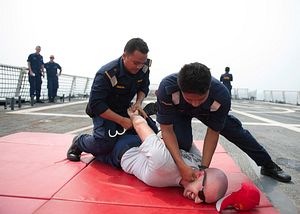This week, local media reports surfaced that Malaysia’s coast guard was looking to set up a new basing facility in the country. The development is in fact just the latest in the agency’s longstanding and ongoing search for new basing facilities as it looks to boost its capabilities and address a wide spectrum of challenges with its growing but still limited resources.
As I have noted before, Malaysia has been just one of several countries in the Asia-Pacific which has been focusing more on boosting its maritime law enforcement capabilities (called “white hulls”) relative to navy forces (termed “gray hulls”) amid several trends as well as growing challenges, including smuggling, piracy, fishing, and militancy (See: “Malaysia’s South China Sea Policy: Playing It Safe”).
In line with this, Malaysia set up its Malaysian Maritime Enforcement Agency (MMEA), the country’s “equivalent of a coast guard,” over a decade ago back in November 2005. Since then, its modest capabilities have gradually grown as part of the country’s wider militarization, from 59 vessels to over 250 ships today according to recent government estimates, with some help from external partners such as Japan (See: “Why Japan’s Malaysia Coast Guard Boost Matters“). As of last year, the MMEA has officially been known as the Malaysian Coast Guard, even though its old name has still been preserved for bureaucratic reasons (See: “Assessing Malaysia’s Coast Guard in ASEAN Perspective”).
Yet for all the inroads it has made, MMEA still faces significant resource constraints. The most often-cited metric is the fact that the MMEA still has too few vessels to even conduct basic policing of the country’s vast coastline, and that the capabilities of the vessels it is seeking to apprehend are far too often greater than its own (See: “Where are Malaysia’s New Warships in its Military Modernization?”). Though that is no doubt true, basing and related infrastructure is an equally important dimension of that resource challenge. That includes not just things like radar systems to boost maritime domain awareness, but also sheer space, be it parking jetties or detention centers that are critical for it to fully execute its law enforcement responsibilities.
Various efforts are already underway to address that challenge, with legislation passed last year that would facilitate increasing the volunteer reserve for the MMEA and establishing dedicated detention facilities under MMEA authority (previously MMEA had to place detainees in facilities of other agencies). The MMEA has also been seeking new basing facilities for itself, realizing it must move away from the previous model of sharing bases and infrastructure with other agencies which limits its effectiveness and autonomy. Construction has previously been eyed in places such as Pahang and Sarawak, though not many details had been publicly disclosed.
On February 15, Minister in the Prime Minister’s Department Shahidan Kassim told reporters amid the MMEA’s 13th anniversary celebrations at the Sultan Ahmad Shah Maritime Academy that the MMEA is looking to set up an East Region base in Pahang to facilitate operations and management in the east coast states and Johor.
The MMEA’s search for basing facilities is not new, and Shahidan’s comments merely confirm the fact that this quest is continuing and the sorts of locations being considered. Indeed, he in fact added that allocation for the new base was approved in July last year, even though he did not reveal the exact amount of the allocation.
Shahidan did not offer much in the way of the specifics, saying only that the department was currently seeking a suitable location for the base and that the contractor of the project had already been appointed. But his comments about the MMEA’s base bid certainly underscore the agency’s efforts to address its old resource challenge.
































